This post may contain affiliate links. Please see our disclosure policy.
Persimmon jam is my favorite way to preserve persimmons in season, and it comes together quickly with just a few ingredients.
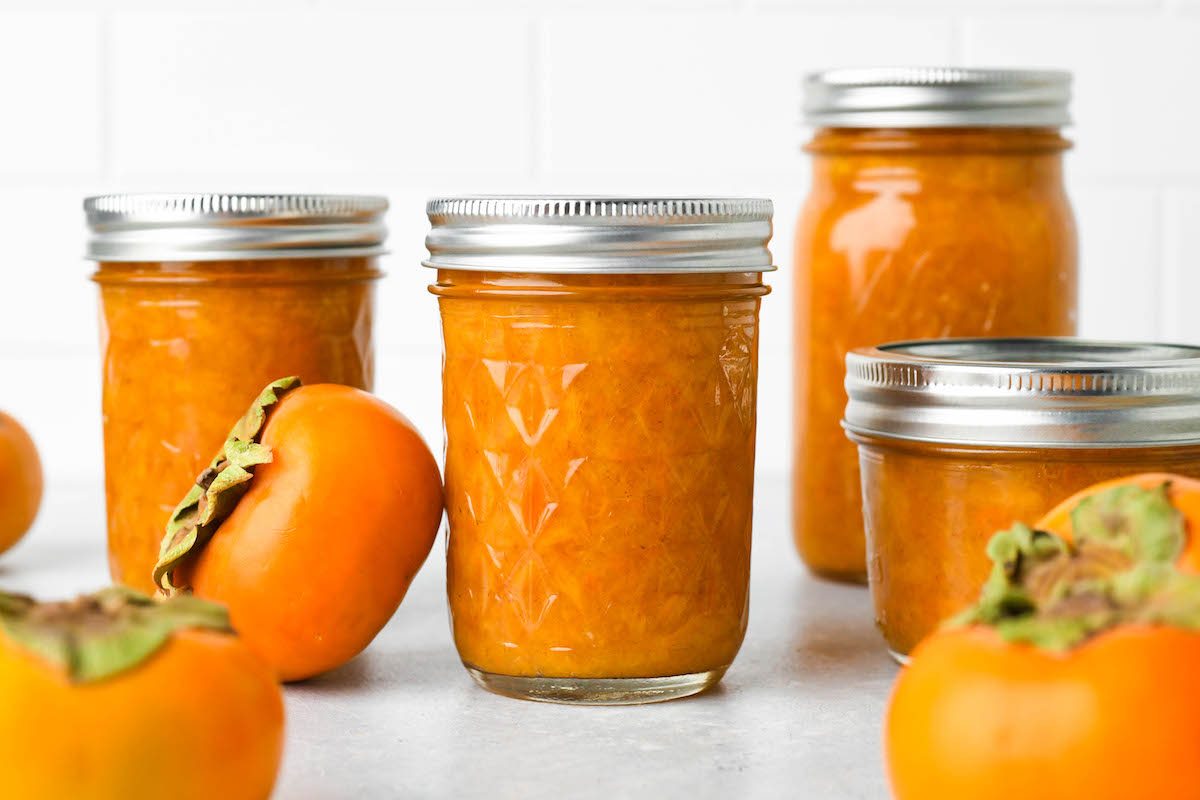
Persimmon jam is one of those preserves you just won’t find in the store, and that’s one reason I really love making it. It’s a taste you just can’t buy, and a gift that can only be given if it’s handmade with love.
Since persimmons have a short season right around the holidays, they’re one of those flavors we associate with seasonal cheer and comfort.
The recipe for persimmon jam is quite simple, since persimmons are naturally full of pectin that helps the jam set. All you need is a bit of sugar and lemon juice to boost their acidity and bring out their flavor.
Just three ingredients, and this homemade persimmon jam sets beautifully!

Are Persimmons Safe for Canning?
When it comes to canning, persimmons are right on the borderline when it comes to a safe pH for jams. Fruit needs to have a pH of 4.6 or lower to be safe for water bath canning, and persimmons generally fall somewhere between 4.4 and 4.7.
Many of the fruits are below the line, but even a few slightly less acidic fruits can push a batch of persimmon jam over the limit.
That’s why it’s incredibly important to add citrus juice (either lemon or lime juice) to this recipe if you’re canning. Lemon juice boosts the acidity in the jar, and lowers the pH to make this a canning safe recipe for persimmon jam.
Even if you’re not canning, the added acidity helps bring out the flavor of the fruit and balance out the sugar. I’d recommend the citrus either way, but it’s not optional if canning.
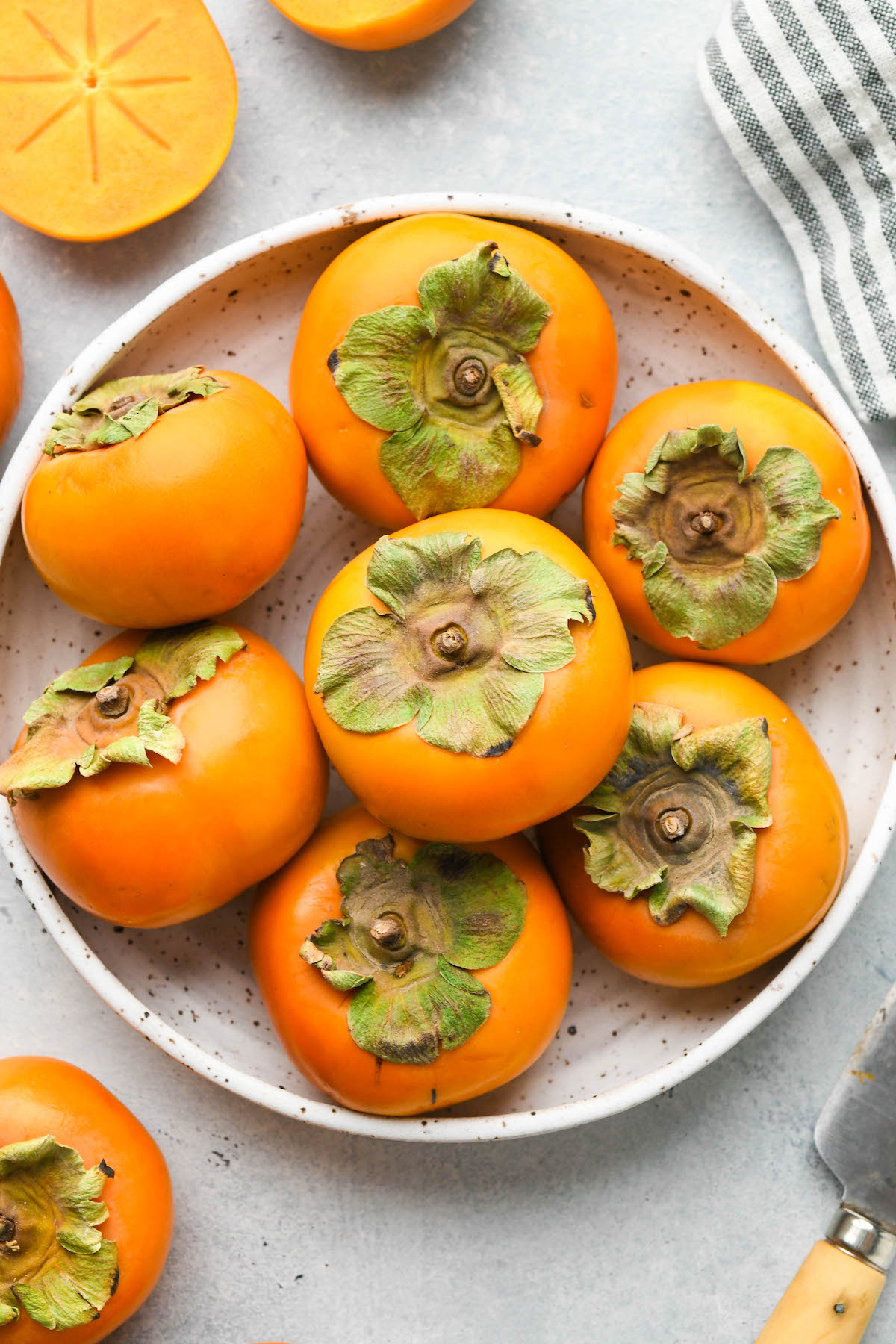
Types of Persimmons for Jam
I’m using fuyu persimmons in this jam recipe, but it’ll also work with wild American persimmons or hachiya persimmons.
Fuyu persimmons are the ones with a firm texture and a flattened UFO shape. They’re ripe when they’re still crisp, but have a slight give to when pressed, somewhat like an asian pear. They’re still a bit crunchy when you bite into them, but sweet.
Hachiya persimmons are very different, and they have an elongated acorn like shape. They’re very astringent until they’re fully ripe and have gone completely soft inside the skin. The fruit will be pudding like and spoon-able once you break the skin, but the astringency will have mellowed. Don’t use these until they’re very ripe.
Wild American Persimmons tend to be more like hachiya persimmons, and ripen to a soft texture. Their astringency and flavor can vary from tree to tree, so be sure you have a tree with good tasting fruit before you begin.
If using the softer American or Hachiya persimmons, be sure to work by weight the soft fruit packs tighter in a measuring cup. It’d guess you’d need around 8-10 cups of fruit pulp with those, instead of the 12 cups of sliced fuyu persimmons.
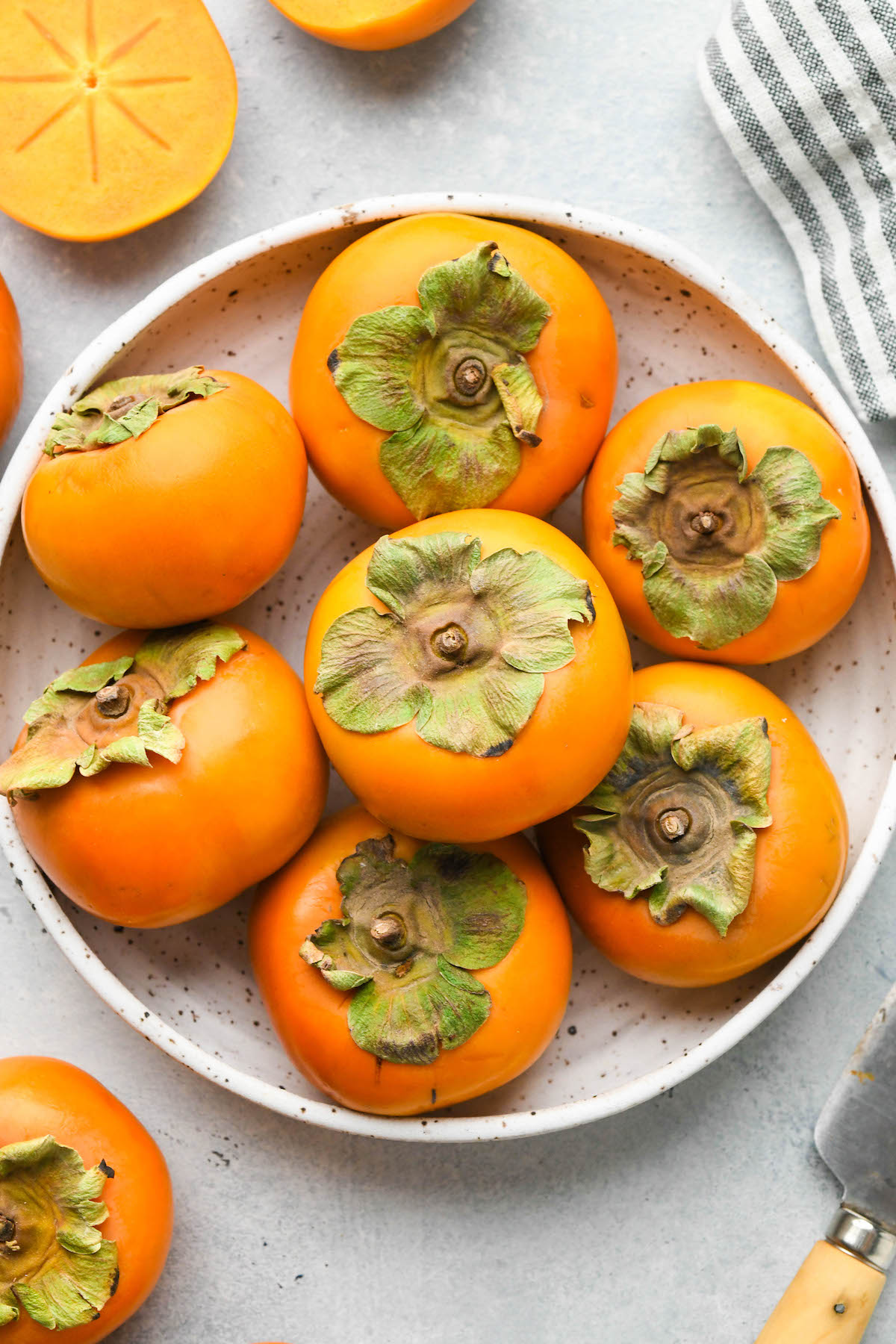
Ingredients for Persimmon Jam
The ingredients for persimmon jam are pretty simple, and for a batch of roughly 4 to 5 half pint jars of jam, you’ll need:
- 4 lbs persimmons, about 10-12 large fuyu persimmons, or about 11-12 cups sliced
- 1 to 2 cups sugar, adjust to your tastes
- 1/4 to 1/2 cup lemon or lime juice
I’m using fuyu persimmons because they’re my favorite, but you can use any type you have available. You’ll want 4 lbs of fresh fruit, which is about 11-12 cups sliced or more like 10 cups diced.
For the sugar, persimmons are naturally quite sweet. I like low sugar jams, so I tend to use around 1 cup of sugar. For an “normal” level of jammy sweetness, use two cups. If you like very sweet old fashioned preserves, you can add more than that, but I think it tends to overpower the flavor of the persimmons.
When it comes to citrus juice, both lemon and lime juice will work. I tend to use lime juice because it compliments the flavor of the persimmons nicely. It’s more acidic than lemon juice, so that’s a fine substitution.
For a “batch,” you need at least 1/4 cup, which is 1 Tablespoon per pound of fresh fruit. I think the jam actually tastes better with more tart flavor notes, so I use 1/2 cup. Know that 1/4 cup is the minimum for safe canning.
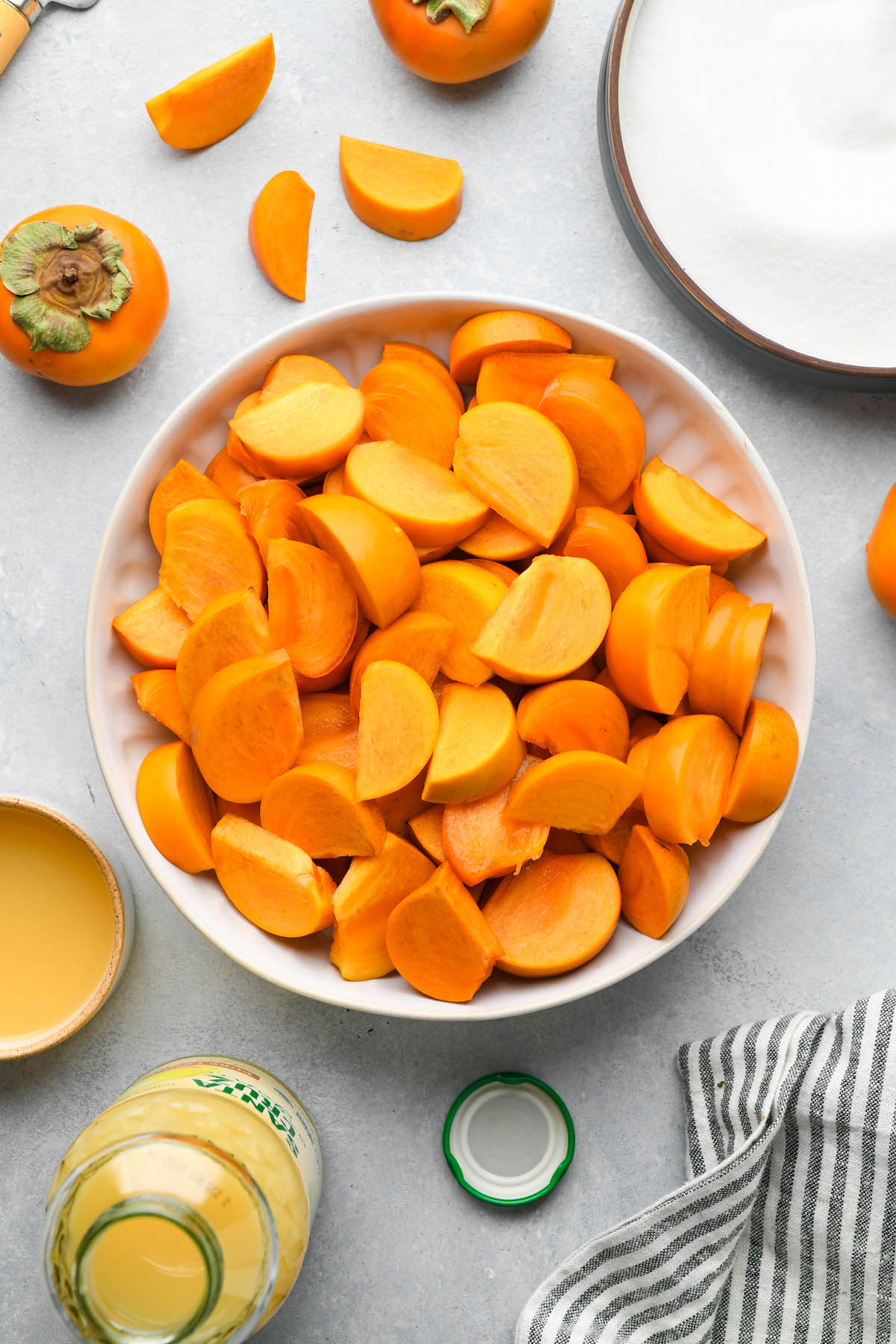
Substituting Citric Acid
If you don’t want to add lemon or lime juice, but still want to add the acidity for to balance the flavor of the jam and make it safe for canning, you can use citric acid instead.
Citric acid granules are much stronger than citrus juice, and they’re used at a rate of 1/4 teaspoon of citric acid in place of each Tablespoon of lemon juice (or lime juice) in a recipe.
This recipe needs at least 1 Tablespoon of lemon juice per pound of fruit, so you’d need 1/4 teaspoon per pound. For a batch, that works out to at least 1 teaspoon of citric acid since the recipe uses 4 lbs fresh fruit.
How to Make Persimmon Jam
Making persimmon jam starts with slicing the persimmons.
Fuyu persimmons are firm and slice well, and their skin adds texture to the finished jam. I don’t peel those, just slice them.
If you’re using wild American persimmons or soft hachiya persimmons, it’s easiest to just slip the skin and the pulp will just fall apart during cooking. You can include the skin sliced up if you’d like, but most people peel those types of persimmons.
Four pounds of fuyu persimmons is quite a bit of fruit, and you should have about 12 cups sliced (or around 10-11 cups if you finely dice them for a less chunky jam).
Place them in a heavy bottomed dutch oven, along with the lemon or lime juice. (If you’re using citric acid, dissolve it in a 1/4 to 1/2 cup of water so there’s liquid in the pan. That’ll keep the persimmons from scorching before they release their own juices.)
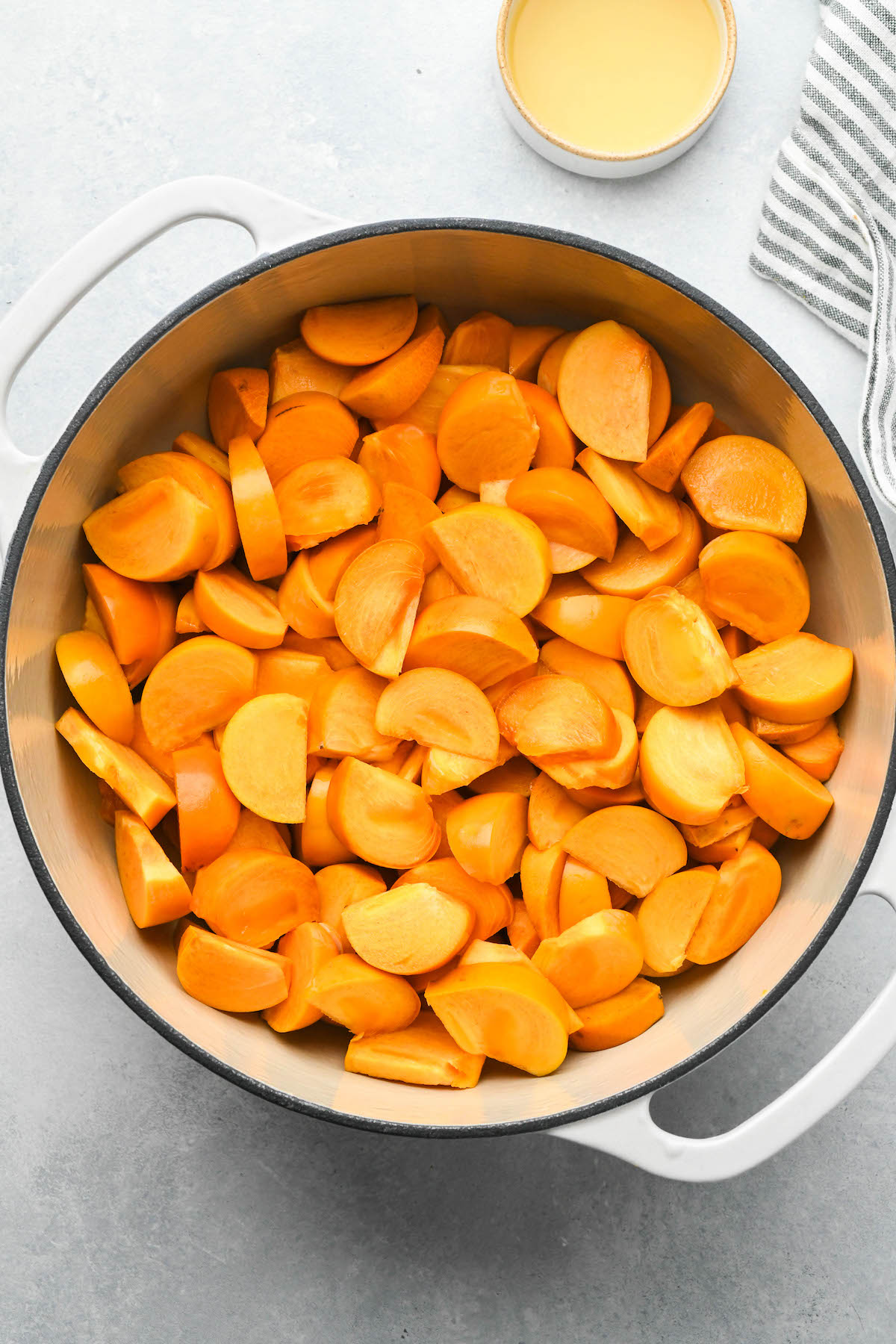
Don’t add the sugar quite yet.
The sugar will firm up the texture of the persimmons, and they won’t cook right if it’s added at the start. They need to fall apart a bit or you’ll end up with persimmon chunks floating in a sugar syrup.
Turn on the heat to medium low and start cooking the persimmons.
They should fall apart pretty quickly as they’re cooked, especially if you’re working with softer hachiya persimmons.
Mash the fruit as it cooks, and after about 15 minutes of gentle cooking the fruit should have more or less completely fallen apart. You should still see some chunks, and the skins will still be visible, but the fruit should have started to “melt” apart in the pan.
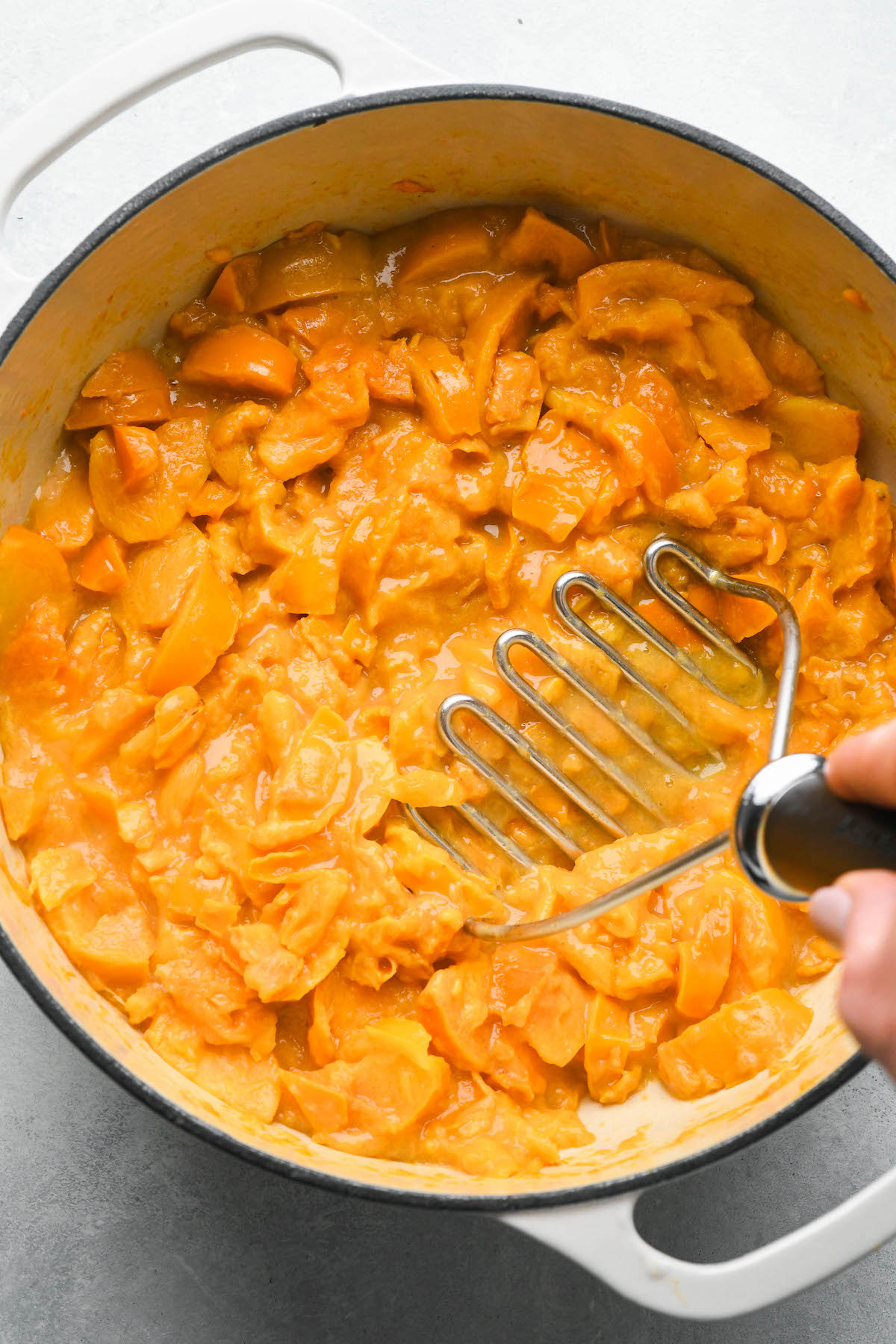
At this point, it’s time to add the sugar. Decide whether you’re adding 1 cup or two. You can start with one, and then taste the jam and decide if you’d like it sweeter.
One cup will result in a just barely sweet jam, and two will give you a more traditional jam flavor. Either way, it’ll set nicely.
Stir in the sugar until it dissolves into the persimmon pulp.
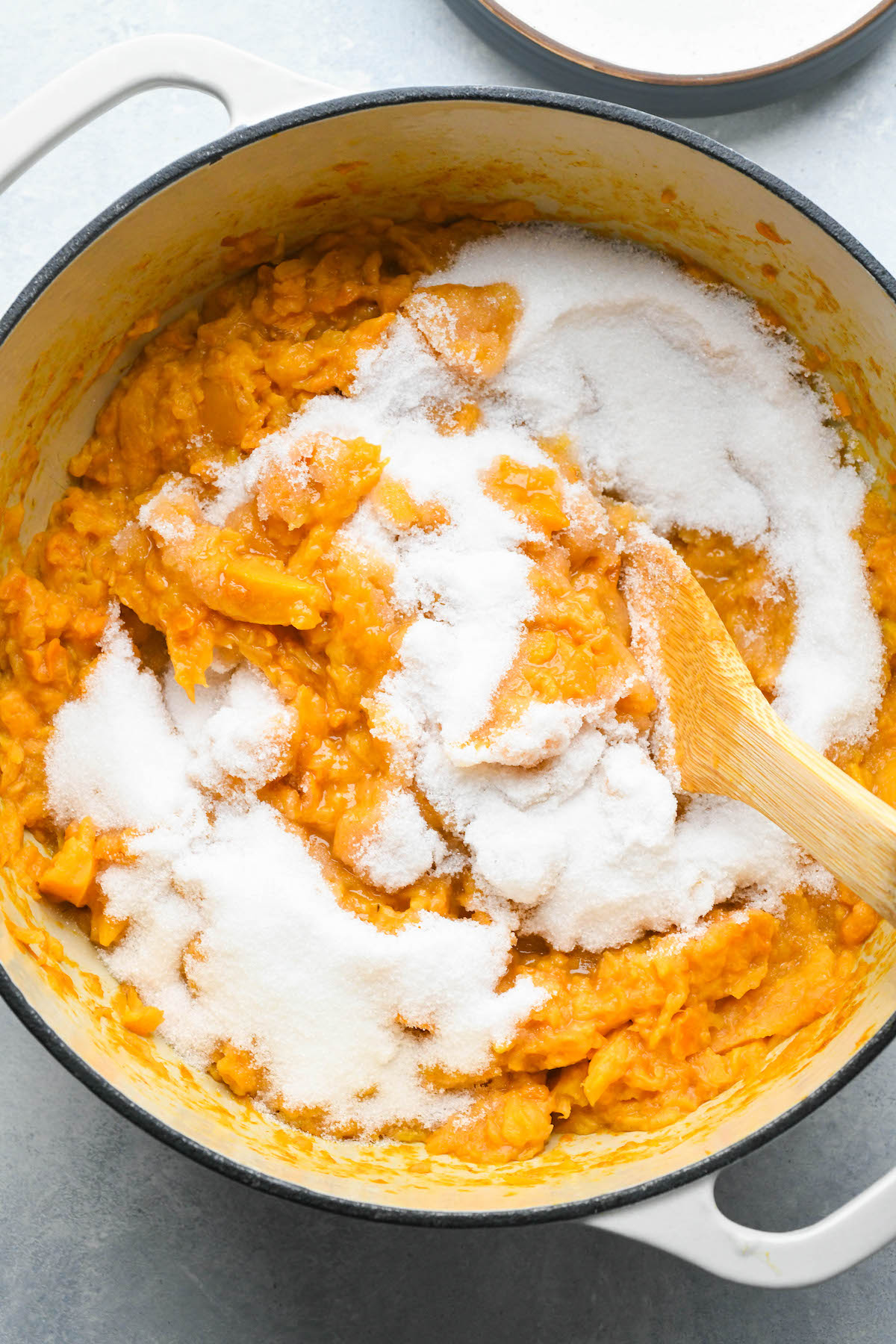
Once you add the sugar, the persimmon pieces will release even more liquid and the jam will temporarily thin out a bit.
Cook the jam over medium heat for another 20 to 30 minutes, stirring frequently to prevent scorching, until it thickens up to your liking. It’s perfectly fine to have a rather thin set if you like, but I tend to like persimmon jam that stands up a bit on the spoon.
That happens at about the 30 minute mark, after the sugar is added. (So in total, that’s about 45 minutes of cooking on medium heat…but stoves vary, so watch it.)
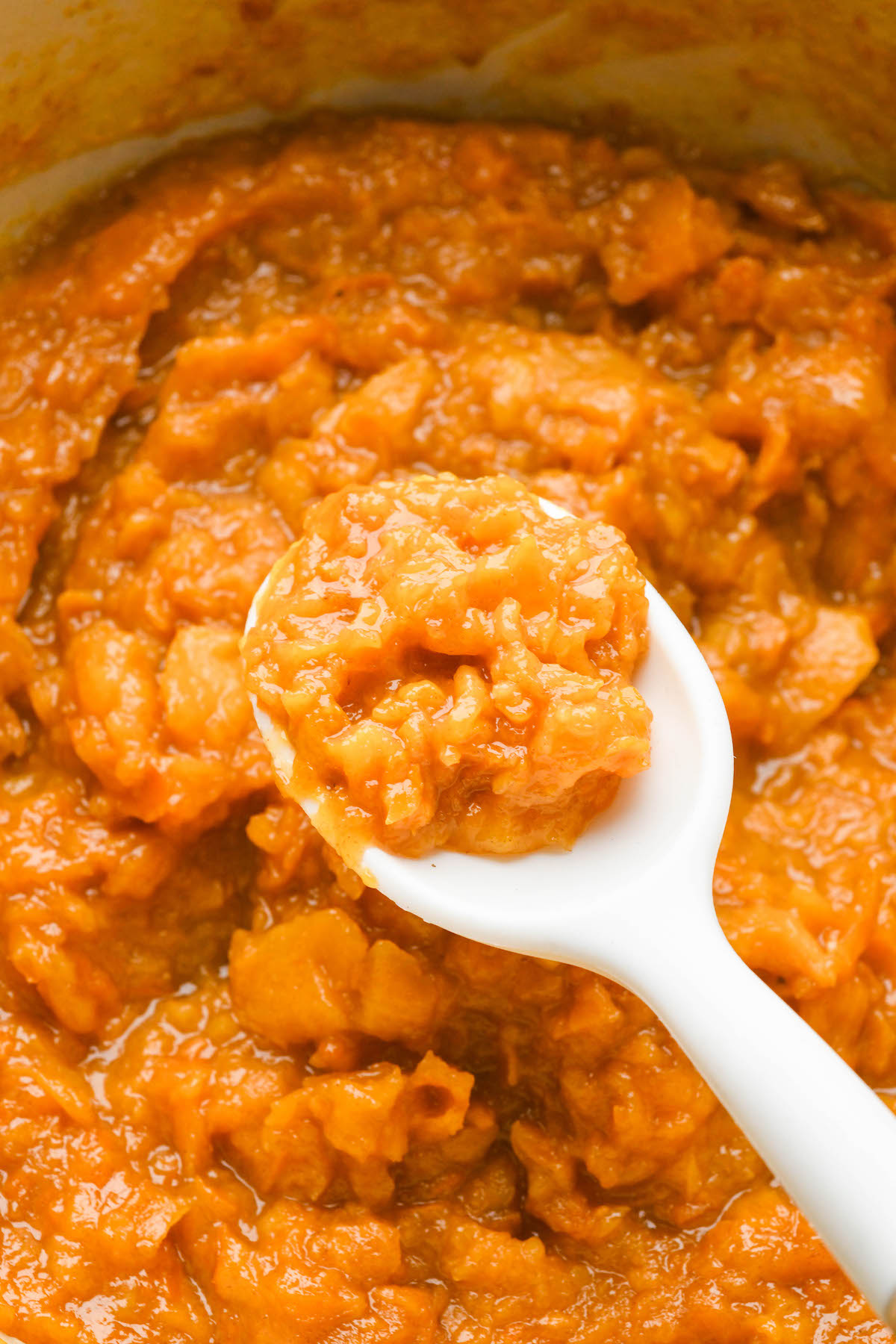
Usually you can test for “set” using an instant read thermometer, but this jam “sets” early and should NOT be cooked until it reaches 220 F. Just watch the texture, and stop cooking when it’s just a bit loser than the final texture you want.
The jam will thicken up as it cools in the jars, so a tiny bit loser than your ideal is the perfect time to turn off the heat.
When you decide it’s ready, turn off the heat and ladle the persimmon jam into prepared jars, leaving 1/4 inch headspace.

If you’re making a refrigerator jam, you can simply cap the jars and allow them to cool on a towel on the counter. Once cool, store in the refrigerator.
They’ll keep for about 1-2 weeks if refrigerated, or up to 6 months in the freezer. (If freezing, be sure to use freezer safe jars.)
Canning Persimmon Jam
While canning is optional, that’s always my preference because it allows me to enjoy the flavor of persimmon jam year round right from my pantry shelf. It also allows me to give the jars as gifts.
If canning, prepare a water bath canner and jars before you begin.
When the jam is done cooking, ladle it into the prepared jars leaving 1/4 inch headspace. Cap with 2 part canning lids and load the jars into the water bath canner.
Turn up the heat on the canner and bring it to a full rolling boil. Once boiling, process the jars in boiling water for 10 minutes, adjusting for altitude.
(If you’re canning, be sure you’ve used at least 1 Tablespoon of lemon juice per pound of fruit so the pH is safe for canning. That’s 1/4 cup for a “batch” with 4 lbs of fruit.)
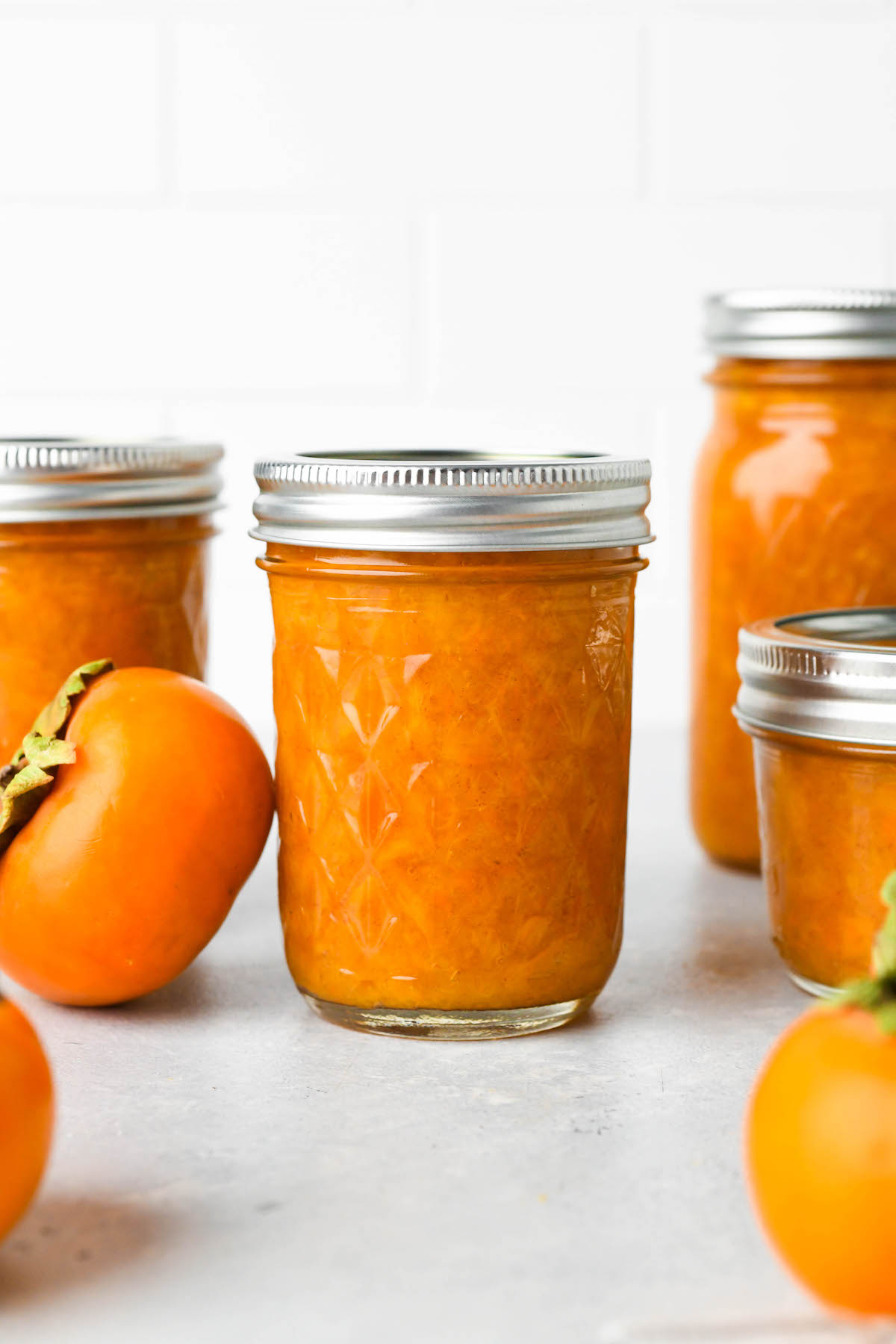
Ways to Use Persimmon Jam
Once you’ve made homemade persimmon jam, you can use it almost any way you’d like. I love it on fresh buttery biscuits on cold winter mornings, but it also works well as a topping for yogurt or ice cream.
Persimmon jam will make a lovely jam thumbprint cookie, and it’s delicious as a filling between two cake layers.
Use it in place of any other type of fruit jam in your favorite recipes.
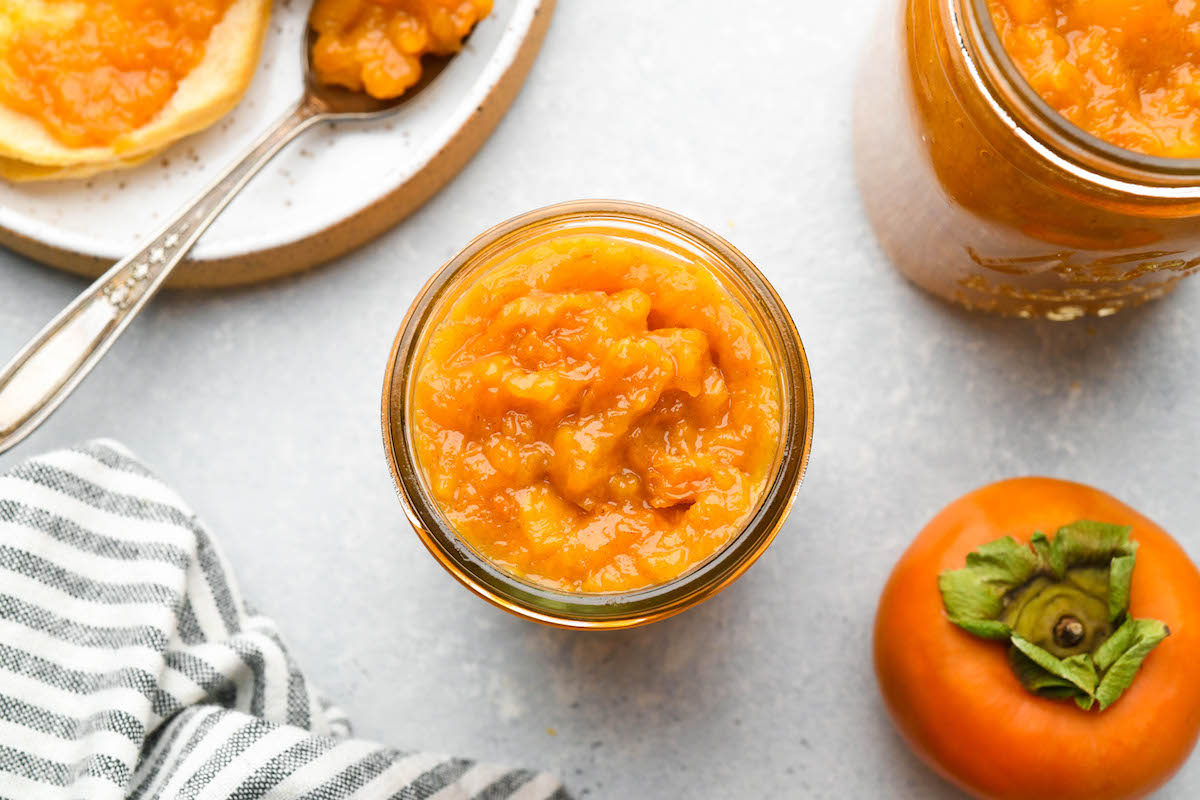
Persimmon Recipes
Looking for more ways to use persimmons?
- Persimmon Champagne Cocktail with Cinnamon and Sage
- Persimmon Sweet Potato Soup
- Persimmon Pie with Vanilla Bean and Pear
- Persimmon Ice Cream
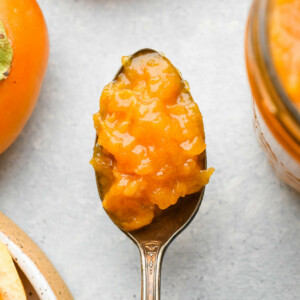
Persimmon Jam (Recipe for Canning)
Equipment
Ingredients
- 4 lbs persimmons, about 10-12 large fuyu persimmons, or about 11-12 cups sliced
- 1 to 2 cups sugar, adjust to your tastes
- 1/4 to 1/2 cup lemon or lime juice, see note
Instructions
- If canning, prepare a water bath canner and jars before beginning. Canning is optional.
- Wash and slice persimmons, removing tops/leaves. You should have around 11-12 cups of slices from 4 lbs fresh fruit.
- Place persimmons in a deep, heavy bottomed stock pot or dutch oven.
- Add lemon juice, but don't add sugar yet.
- Turn on the stove to medium heat and cook the persimmons for about 15 minutes. Stir frequently to avoid scorching and mash with the fruit to encourage it to break apart.
- After about 15 minutes of cooking, the fruit should have mostly fallen apart. Add the sugar and stir to dissolve.
- Continue cooking the jam over medium heat for another 20 to 30 minutes, stirring frequently. The jam should thicken up nicely.
- When the jam reaches your desired consistency, remove the pan from the heat.
- Ladle the finished persimmon jam into prepared jars, leaving 1/4 inch headspace. Cap with 2 part lids.
- If canning, load the jars into a water bath canner and turn the heat up to high to bring the canner to a full rolling boil. Once the water is boiling, start a timer and process the jars in a boiling water bath canner for 10 minutes, adjusting for altitude. Remove the jars and allow them to cool on a towel on the counter. After 12 to 24 hours, check seals and store any unsealed jars in the refrigerator for immediate use. Properly canned and sealed jars will maintain peak quality on the pantry shelf for 18 months, and keep much longer. Refrigerate after opening.
Notes
Sugar
For a just barely sweet jam, use 1 cup of sugar. For a traditional full sugar jam, go with 2 cups. The yield will be higher with more sugar.Lemon or Lime Juice
Persimmons are not very acidic, and the lemon juice helps add tart flavor notes to balance out the sugar. It also adds pectin to help the jam set. Lime juice works as well, and adds its own unique flavor. For a refrigerator jam, the lemon juice is optional, but highly recommended for both flavor and set. If canning, the lemon juice is not optional, and is required to lower the pH of the fruit to safe levels for canning. You must use at least 1/4 cup per batch (4 lbs fruit). that's 1 Tablespoon per pound of fruit. Personally, I like more citrus juice in my persimmon jam, which brings out the flavor of the fruit better. I use 1/2 cup, or 2 tablespoons per pound of fruit.Citric Acid Substitution
If you don't want to add the flavor of citrus juice to your jam, but still want to lower the pH for safe canning, you can use citric acid granules instead. Citric acid granules are much stronger than citrus juice, and they're used at a rate of 1/4 teaspoon of citric acid in place of each Tablespoon of lemon juice (or lime juice) in a recipe. This recipe needs at least 1 Tablespoon of lemon juice per pound of fruit, so you'd need 1/4 teaspoon per pound. For a batch, that works out to at least 1 teaspoon of citric acid since the recipe uses 4 lbs fresh fruit. Dissolve the citric acid in 1/4 to 1/2 cup water and add it in place of the citrus juice in the recipe.Nutrition
Nutrition information is automatically calculated, so should only be used as an approximation.
November Canning Recipes
Persimmons ripen late in the season, usually in November and even into December, but they’re not the only late season fruit available this time of year!
- Cranberry Sauce
- Quince Jam
- Kumquat Jam
- Canning Quince (coming soon)
Old Fashioned Jam Recipes
Do you like making jam the old fashioned way, without added boxed pectin?
- Old Fashioned Strawberry Jam
- Old Fashioned Grape Jam (with Skins)
- Classic Raspberry Jam (No Pectin Added)
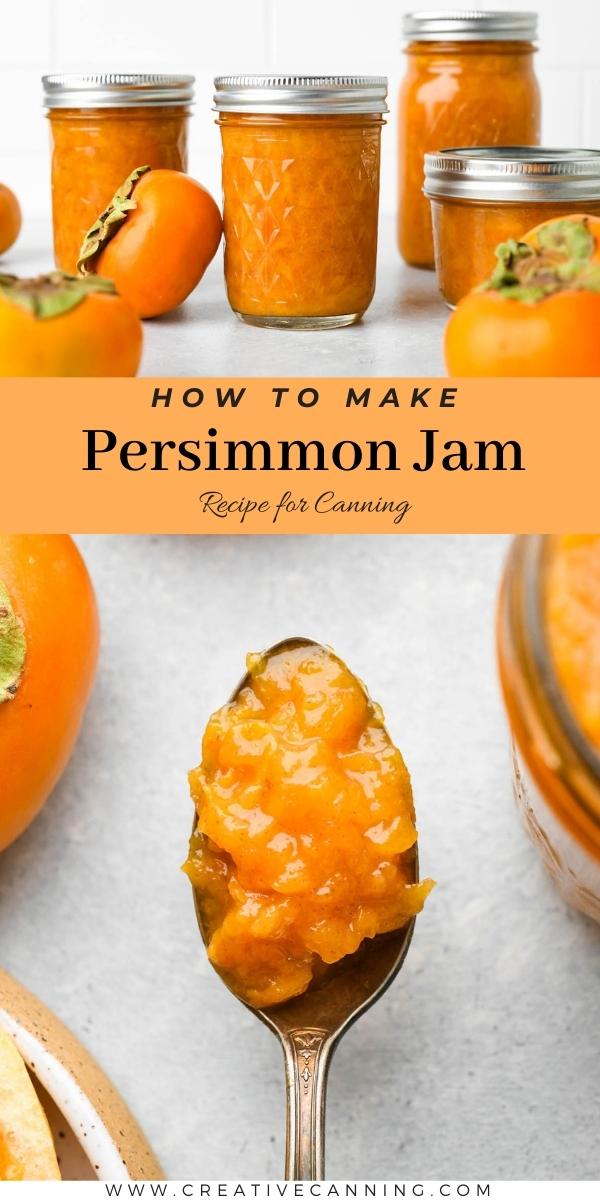

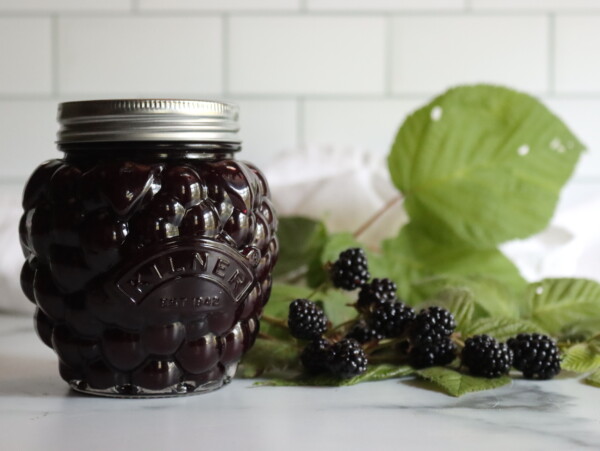

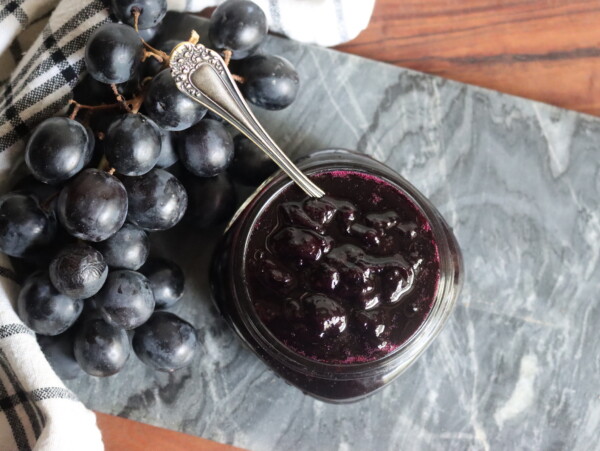
Good jam recipe. My first ever making persimmon jam. Worth the effort. Good with cream cheese on a good bread toast.
This was absolutely delicious!
Wonderful! So glad you liked it.
Delicious recipe! Our Fuyu persimmon tree was prolific this year! I sliced, de-seeded, and cut out any unattractive peel. I used two freshly squeezed lemons. While cooking (30 minutes), I worked to mash the fruit, but eventually I blended about half the mixture as it was far too chunky otherwise. I added cinnamon at the end. The jam is delicious, but I would definitely peel the fruit next time as I have strands of peel, giving the jam a bit of a “crunchy” texture. I also agree with another reviewer. We don’t treat the tree with any herbicides, etc., so our peels can have flaws – another reason to peel first. I canned the jam and will give it to friends over the holidays!
I used ripe American persimmons and the jam curdled. I wonder if I should have added the sugar first and then added the lemon juice at the end.
I’ll still use the curdled mass in a bread or something but not as jam!
That’s a strange one, I’ve never had persimmons curdle. Sorry that happened to yours, I wonder what could have happened?
Thoughts on fresh vs bottled lemon juice? I used a combo of about 25% fresh lime juice and 75% fresh lemon juice, with lemons and limes gifted from a friend so I don’t know exactly what variety. I didn’t realize you typically use bottled for consistent acidity.
Usually yes, you use bottled when you’re adding it for safety rather than for flavor. Some recipes you can use fresh, which gives better flavor. This one does need the acidity from the bottled juice. If you’re using the minimum amount of juice in this recipe, then I’d stick with bottled. If you went with a bit more, around 1/2 cup, then you’re well over the margin of error and can use fresh.
Lovely I personally prefer chunky jams, and I like easier steps, so this recipe was perfect. I used 1 cup sugar and 1/2 cup lime juice. I have a Fuyu tree which was very happy this year!
Wonderful, so glad you enjoyed it!
Can I freeze the fruit until I am ready to make and can?
Yes, that’s fine!
What about the seeds?
If you have seedy persimmons, you’ll need to take them out. All the persimmons we get here are seedless.
tried it exactly as the recipe, except I peeled them. being organic there was some flaws etc on the peels, and wanted it to be as pure as possible. It came out fabulous!!! And I agree the lime juice is a wonderful compliment. only used 1 cup sugar and it was plenty sweet. amazing!
Wonderful, so glad you enjoyed it!
Could spices like cinnamon be added to this recipe?
Yes, you’re always allowed to add dry spices to canning recipes. Enjoy!
Do you peel them?
Nope, I just use them as they are.
Thank you for this recipe. My persimmons varied in ripeness. I used fuyu. So the consistency was somewhat chunky even though I diced them up small and cooked for the for 30 minutes. I did not add sugar until after the 15 minutes. I noticed air bubbles after removing from the canner. Is that normal and OK as long as I have a good seal?
Some air bubbles are normal and fine in canning. Ideally, you’d remove as many as possible in the “de-bubbling” stage before putting the lids on, but there’s always some, especially if the jam has cooled slightly before it goes into the jars. Air bubbles can cause oxidation in a jam, so you may notice some discoloration after a few months. The jars should be fine so long as they’re sealed and properly canned, but you might want to use them up sooner rather than later.